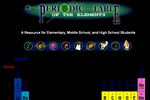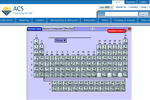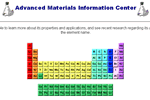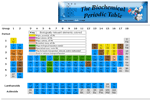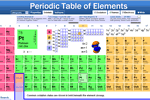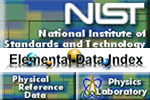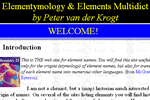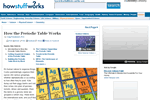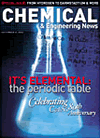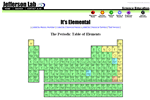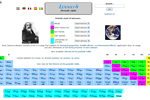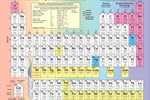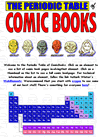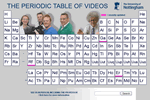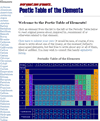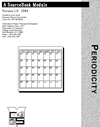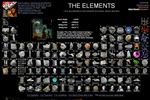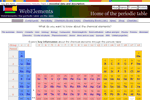Online Resources
This is a collection of online resources (websites, software, etc.). A separate collection of Print and Video Resources is also available.
Key: E=Elementary (K–5), I=Intermediate (6–8), HS=High School (9–12), C=College, G=General Public
- A Periodic Table of the Elements: A Resource for Elementary, Middle School, and High School Students (E, I, HS)
- Includes brief information about the history, sources, properties, uses, isotope,
costs, and handling for each element.
Provided by: the Los Alamos National Laboratory. - ACS Periodic Table (I, HS, C, G)
- An interactive periodic table that includes properties, electron configuration, and plot data.
Provided by: American Chemical Society. - Advanced Materials Information Center (HS, C, G)
- Click an element name on the Periodic Table to learn more about its properties and
applications, and see recent research regarding its uses. You may also search
alphabetically by the element name.
Provided by: American Elements. - Biochemical Periodic Table (I, HS, C, G)
- The University of Minnesota Biocatalysis/Biodegradation Database Biochemical Periodic
Tables provide an overview of microbial interactions with essential and nonessential
chemical elements. Information on individual elements is accessible through two
representations of the periodic table of the elements: the traditional periodic table
and the spiral periodic table. The spiral table is a more biologically relevant
representation of the chemical elements, as it places hydrogen in a central position
clustered with the other primary components of biological molecules (carbon, nitrogen,
oxygen, phosphorus, and sulfur). The content accessed through the traditional and spiral
tables is identical.
Provided by: The University of Minnesota. - Chemistry in its Element (I, HS, C, G)
- Introducing Chemistry in its element: a tour of the periodic table. A leading scientist
or author tells the stories behind the elements in each weekly five minute podcast.
Provided by: Royal Society of Chemistry. - Dynamic Periodic Table (E, I, HS, C, G)
- Use the check boxes at the top of the page to dynamically switch between simple, with
names, with electron configuration, and inline inner transition metals. View as much or
as little information as you’d like or your screen allows. Check out the 3D orbitals!
This site is all HTML (no Flash).
Provided by: Michael Dayah, Knoxville, Tennessee. - Elemental Data Index (C)
- The Elemental Data Index provides access to the holdings of NIST Physics Laboratory
online data organized by element. It is intended to simplify the process of retrieving
online scientific data for a specific element. NIST Standard Reference Database 105.
Provided by: the U.S. National Institute for Standards and Technology. - Elementymology & Elements Multidict (I, HS, C, G)
- This is THE web site for element names. You will find this site useful not only for the
origins (etymology) of element names, but also for translations of each element name into
numerous other languages.
Provided by: Peter van der Krogt. - HowStuffWorks “How the Periodic Table Works” (E, I, HS, C, G)
- “It’s human nature to organize things. Cooks painstakingly organize their
spices into various groupings, whether alphabetically or according to how often they’re
used. Kids dump out their piggy banks and sort their riches into piles of pennies, nickels,
dimes and quarters. Even the items in a grocery store are grouped a certain way. Head down the
international aisle, and you’ll find packages of Chinese egg noodles sitting next to
boxes of taco shells. Chemists, as it turns out, are organizational junkies, too. They look
for similar physical and chemical properties among the elements, the basic forms of matter, and
then try to fit them into similar groups.”
Provided by: HowStuffWorks.com. - It’s Elemental: The Periodic Table (I, HS, C, G)
- The Periodic Table is nature’s Rosetta stone. To the uninitiated, it’s just 100-plus
numbered boxes, each containing one or two letters, arranged with an odd, skewed symmetry. To
chemists, however, the periodic table reveals the organizing principles of matter, which is to say,
the organizing principles of chemistry. At a fundamental level, all of chemistry is contained in the
periodic table. The periodic table is so central to chemistry that it seemed natural to devote a
special issue to it and the elements that compose it as we celebrate C&EN’s 80th
anniversary. The 89 essays are delightfully varied. We hope they will give you a new perspective on
and appreciation of the building blocks of our science.
Provided by: American Chemical Society. - It’s Elemental — The Periodic Table of Elements (E, I, HS)
- Includes some online games based on the periodic table, as well as other paper based activities.
Provided by: Thomas Jefferson National Accelerator Facility — Office of Science Education. - Lenntech Periodic Table with Environmental and Health Factors (I, HS, C, G)
- Each chemical element contains a link to a page that explains its chemical properties,
health effects, environmental effects, application data, an image and also information of
the history/inventor of each element. Also includes a brief history of the periodic table.
Provided by: Lenntech Water Treatment & air science, The Netherlands. - Periodic Table: Atomic Properties of the Elements (I, HS, C, G)
- A periodic table, containing NIST critically-evaluated data on atomic properties
of the elements [SP 966] was designed as a NIST handout for use at exhibitions and
trade shows. The publication of the handout coincided with NIST’s centennial
celebration in 2001. One side of the handout (shown below) is available online in
two formats (PDF & TIFF), and is suitable for high-resolution color printing
for desk or wall-chart display. [The other side of the handout (not available
online) contains historical information.]
Provided by: the U.S. National Institute for Standards and Technology. - Periodic Table of Comic Books (E, I, HS, C, G)
- Click on an element to see a list of comic book pages involving that element. Click
on a thumbnail on the list to see a full comic bookpage. For technical information
about an element, follow the link to Mark Winter’s WebElements. We recommend
that you start with oxygen to see some of our best stuff. There’s something for
everyone here!
Provided by: F. James Holler and John P.Selegue, Chemistry Department, University of Kentucky. - Periodic Table of Videos (E, I, HS, C, G)
- Tables charting the chemical elements have been around since the 19th century —
but this modern version has a short video about each one. Since launching this site, our
videos have been watched more than 5.8 million times. But we’re not finished yet.
We’ve started updating all the videos with new stories, better samples and bigger
experiments.
Provided by: The University of Nottingham, UK. - Poetic Table of Elements (E, I, HS, C, G)
- Click an element from the list to the left or the Periodic Table below to read original
poems about, inspired by, reminiscent of or otherwise related to that element.
Provided by: everypoet.com. - SourceBook — chapter on Periodicity (pdf) (HS, C)
- Teacher’s guide with student lab activities. Written by Michael Abraham, Donna
Deen-Coshaw and William Fix, edited by Sr. Mary Virginia Orna.
Provided by: David Brooks, University of Nebraska. - Theodor Gray’s Periodic Table of the Elements (E, I, HS, C, G)
- Sometimes referred to as the most beautiful Periodic Table, users can click on any
element to see hundreds of pictures, stories and facts. This website is a complete
periodic table reference containing just about all the information a student would
need to know about each of the chemical elements. It is based on a combination of
research-grade technical data with a very large volume of text about, and photographs
of, the elements and their applications.
Provided by: Theodor Gray. - Visual Elements Periodic Table
- The Visual Elements Periodic Table is an arts and science collaborative project from
the RSC which explores the diversity of elements in a unique and innovative manner. The
website includes: Data on the elements, Patterns in the periodic table, Atomic orbitals,
Alchemical symbols, Downloadable movies, screensavers and soundtracks, and e-postcards.
Provided by: Royal Society of Chemistry. - WebElements Periodic Table of the Elements (I, HS, C, G)
- What do you want to find about the chemical elements? Explore this popular version of the
periodic table that includes information about The essentials, History, Uses, Geology, Biology,
Compounds, Electronegativity, Bond enthalpies, Lattice energies, Physics, Pictures, Allotropes,
Chemistry, Crystal structures, Thermochemistry, Atoms, Atom and ion sizes, Isotopes, NMR, and
Orbital properties.
Provided by: Mark Winter, University of Sheffield, UK.

